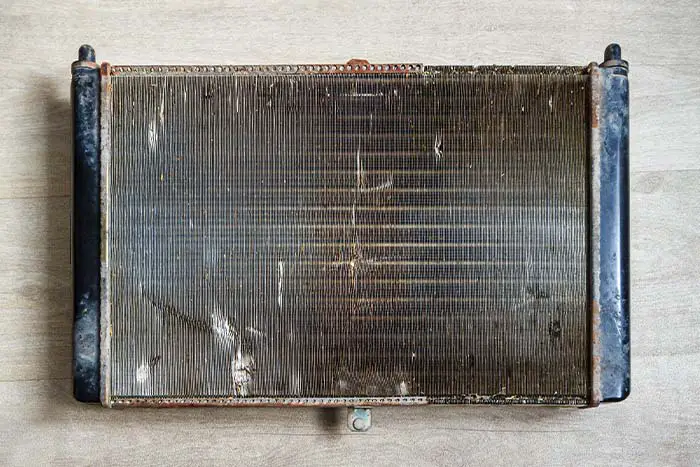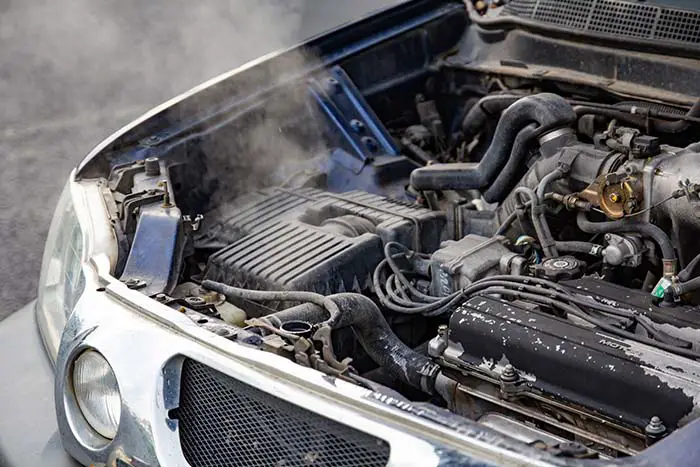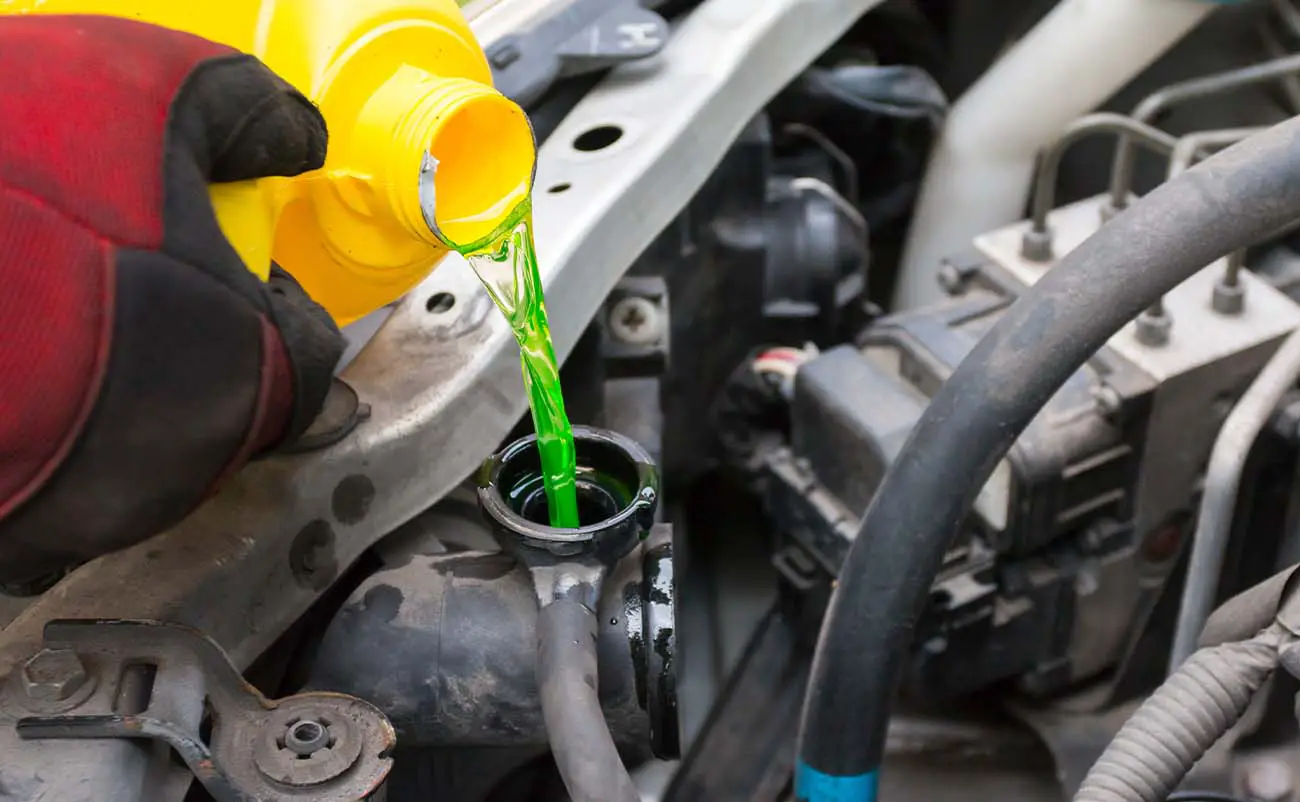We hate to be the bearer of bad news, but oil in your coolant is a serious problem that needs to be addressed immediately. Oil and coolant should not mix as they serve different purposes. When they do, it’s not good news for your car’s engine. This can lead to major damage and repair bills that will cost you more than you’d like to think about.
Oil in your coolant is a sign that something is seriously wrong with your car. It could be caused by a blown head gasket, which you can fix if you’re lucky, or by a cracked engine block — a problem that will be expensive and require extensive repairs. Keep reading as we tell you about the common causes, symptoms, and effects of oil in your coolant.
Table of Contents
What Causes Oil To Mix With Your Coolant?

Your coolant is the liquid that runs through your car’s engine to maintain a safe operating engine temperature. This fluid is the lifeblood of your car’s engine, and it needs to remain clean and free from contamination.
If you notice oil in your coolant, there could be a few different reasons why this is happening. It could be something simple — like a loose drain plug — or something more serious. If you’re unsure about what’s causing the oil to mix with your coolant, check out these common causes.
— Blown Head Gasket
Oil in your coolant can be a sign of a leaky head gasket that needs to be replaced. The head gasket may be blown because of overheating, which could be caused by a clogged radiator or water pump. A blown head gasket is a major problem for any car. It means there is a leak in the seal between the cylinder head (the top part of your engine) and the engine block (the bottom part). The result is that coolant enters the oil system and mixes with it, causing an oil leak that makes its way into your coolant system.
— Cracked Engine Block
A cracked engine block is the most common cause of oil mixing with coolant. A cracked engine block can happen because of age, rust, or even just from repeated heating and cooling cycles. When an engine block cracks, it creates a pathway for oil to leak into your coolant system. It will also cause you to lose coolant over time and lose valuable power from your engine due to excess friction caused by having mixed oil and water circulating together in your cooling system.
— Cracked Cylinder Head
The cylinder head is the part of your engine that houses the valves and spark plugs. It allows fuel to enter the combustion chamber, where it will mix with air to create a combustible mixture. A cracked cylinder head can cause oil to mix with your coolant. A cracked cylinder head can also cause motor oil to mix with your coolant because it allows air to leak into the combustion chamber through its cracks. This causes a lack of compression, which can also trigger a misfire in your engine, resulting in higher than normal temperatures, which may cause you to see oil in your coolant.
— Failed Engine Oil Cooler
The engine oil cooler is responsible for keeping engine oil at the proper operating temperature, so it doesn’t break down or get too hot. If your engine oil cooler has failed, you’ll have excess heat in your engine and oil that’s too hot. When this happens, the heat from your engine will start to build up in the coolant, causing it to boil and turn into vapor. That vapor will then find its way into your car’s cooling system — and eventually into your radiator cap — where it will mix with the coolant and cause problems with your car’s performance.
— Faulty Transmission Fluid Cooler
A transmission fluid cooler is a separate unit from the engine coolant system. It is responsible for cooling the transmission fluid to prevent it from overheating and causing damage to the transmission. A faulty transmission cooler can cause oil to mix with your coolant.
Signs Of Oil In Your Coolant

Your car’s coolant system is designed to keep your engine at a safe temperature, and you must monitor it regularly. If you notice any of the following signs, it’s time to get your vehicle checked out by a professional mechanic.
— Murky Liquid In Coolant Reservoir
One of the most common signs of oil in your coolant is murky liquid in the coolant tank. This may be initially noticed as an oil film on top of the coolant. If you see a lot of brownish or blackish liquid there, it’s time to get the car checked out.
— White Smoke From Exhaust
Did you know that white smoke from your car’s exhaust is a common sign of oil in your coolant? Whether it’s coming from your tailpipe or the top of your engine, white smoke is one of the more visible symptoms of an oil leak. A strong smell can also accompany this. Like candy or fruit, the smell may be sweet, but it can also be chemical or otherwise unpleasant. If you notice any of these signs, you should have your vehicle checked as soon as possible.
— Overheating Engine
If you’re driving and suddenly notice that the temperature gauge on your car is going up, it could be a sign that there is oil in your coolant. This can happen when you have a leak in the engine or when an engine part has been damaged. The leak will allow oil to enter the coolant system, causing it to overheat and eventually fail.
— Fluid Leaks Under Vehicle
This can be difficult to detect because there may not be any visible signs of a leak. However, if you see puddles of liquid around the engine or oil stains on the ground under your vehicle, there is probably an oil leak somewhere on your engine.
What Happens When My Oil And Coolant Mix?
For starters, there’s the sludge build-up. This thick, goopy substance sits on top of your engine’s coolant lines and clogs them up. This means that your car isn’t getting adequate cooling and could overheat easily. It also means that your car may not be able to get rid of its heat as efficiently as it should and will struggle to drive itself. In addition, because this sludge is so thick, it can damage the engine if left untreated for long periods.
The second thing that happens when oil and coolant mix is corrosion. Corrosion causes damage to everything from pistons to spark plugs — everything in between — in your car’s engine block. This means that your engine could suffer from poor performance or even stop working altogether if you don’t take action immediately!
When oil and coolant mix, they form an emulsion, an unstable mixture of two substances that don’t normally mix. In this case, we’re talking about water and oil. Because of its unstable nature, an emulsion is likely to break down into separate parts again. This can lead to serious engine problems for your car.
How To Repair Your Car When Oil Mixes With Coolant

It’s important to be able to repair the damage before the engine starts acting up. Oil and coolant are not supposed to mix, but they can cause serious damage to your car’s engine when they do. The good news is that you can repair the leak if you know what caused it in the first place and how to fix it. You may need professional help with some of these repairs, so check with a mechanic before attempting these fixes yourself.
— Have A Mechanic Pressure Test The Cooling System
Have a mechanic pressure test the cooling system. If the radiator is leaking, have it replaced. If it’s not leaking, but you still suspect a problem, have it pressure tested again just in case the leak has stopped or slowed down enough to make the engine run hot without showing an obvious leak. If there’s no evidence of coolant leaks, you may be able to save time and money by not replacing the coolant.
If there are leaks around seals or gaskets, these can be replaced. It isn’t uncommon for some seals and gaskets to wear out after repeated heating and cooling cycles. The best way to tell if they’re worn out is to check whether they’re leaking coolant when you should be checking other things (such as the radiator cap). If your car has been overheating, some parts of your engine may have been damaged by sustained exposure to high temperatures. That’s especially true if you drove with no oil in your engine — or with contaminated oil — for a long time; even if there aren’t any visible signs of damage yet, the damage may already be done internally.
— If Pressure Tests Reveal A Damaged Head Gasket, It Must Be Replaced
First, check underneath your car to make sure all of the coolant has been cleaned up. Then, remove the spark plugs and oil filter. This will help keep them from getting damaged during the repair process. Next, remove the hoses and loosen the bolts holding down the engine cover. Once these are removed, lift off the cover and set it aside so you can access all of your car’s engine parts.
Then, using an old rag or paper towels to protect yourself from any remaining coolant inside, remove all of the old gaskets from around the cylinder head and cylinder block where they meet up together. Be sure to clean up all of this material before proceeding further with your repairs because if some remains behind, it could cause future problems for you later down the road if left unattended!
Once this is done, replace any parts as needed (such as a new gasket) before reinstalling everything back onto its original position again within your automobile engine compartment area, making sure not to forget anything else along the way either!
— The Engine Block Can Be Chemically Cleaned
This is a permanent fix, but it’s not cheap. You’ll need to drain the coolant and oil from your car, then take it to an auto parts store for a chemical cleaning. The cost is about $200, plus another $100 or so for labor. If it’s impossible to clean the engine block thoroughly, replacement is the only real option.
Even though there’s no single “right” way to fix this problem, it’s important to have repairs performed as soon as possible. It’s not safe to operate a vehicle with a compromised coolant system, and mixing oil and coolant will eventually lead to a problem that leaves you stranded on the side of the road.
Cost To Repair Oil In Your Coolant
The cost to repair an oil leak in your coolant depends on how bad the leak is, how much extra work needs to be done to fix it, and what kind of vehicle you have. For example, if you have an older car with a small engine, replacing a gasket can cost less than $100. On the other hand, if you have a newer car with a bigger engine and more complicated parts, it could cost as much as $2,000 or more just to get started!
First, find out where the leak is coming from. If you’re lucky, it might just be a tiny crack in one of the hoses or freeze plugs. That’s pretty easy to fix and should only cost you $50-$100 if you need to buy new parts. But if the leak goes deeper into the engine block itself, things get more complicated. It can take hundreds of dollars in parts and labor hours to repair an engine. It usually involves replacing damaged gaskets or seals with brand new ones instead of repairing them with epoxy glue or some other temporary solution.
The Bottom Line
There are several telltale signs that you might have oil in your coolant and many possible root causes for this issue. As long as you address it promptly, you can easily get your car repaired and prevent extensive engine damage. Above all else, be thorough when looking over your engine and waiting for a professional diagnosis.
Frequently Asked Questions
Can you drive a car with oil in the coolant?
Yes, you can, but it’s not recommended. The main reason is that the oil in your coolant will contaminate your engine. This will eventually cause damage and shorten the life of your engine. The other reason is that if there is a lot of oil in the cooling system, it may get into the combustion chamber or exhaust pipe, which can cause problems for your catalytic converter or oxygen sensor.
How do I get rid of oil in my coolant system?
If you have an internal engine problem, the best way to fix it is to take your car to a mechanic. If you don’t want to take your car in for a costly repair, you might want to make it a DIY project and replace the coolant yourself. Coolant contains a small amount of ethylene glycol, which is toxic and can cause severe burns if ingested. Be sure to wear gloves and protective eyewear when working with coolant.
The first step is to drain the coolant from your radiator. You can do this by taking off the cap on top of your radiator and letting it drain into a bucket or another large container. After this has been done, run your engine until there is no more water coming out of the radiator cap. Letting your engine run for about 30 minutes should be enough time for all of the water inside your engine’s cooling system to evaporate into the air around your car’s engine compartment.
Once you’ve let all of that water evaporate from inside your car’s cooling system, fill it up with a new automotive coolant mixture (which should come with instructions). It would be best if you used only new antifreeze/coolant mixture.
Can oil in coolant cause a car to overheat?
Yes, it can. When the oil circulates through the engine, it helps with lubrication and cools its moving parts. But when too much oil is in your engine, it can cause sludge to form. Sludge is a thick deposit of carbon and other combustion products that stick together and accumulate in your engine. This accumulation can lead to overheating due to restricted flow and reduced cooling capacity of the radiator.

